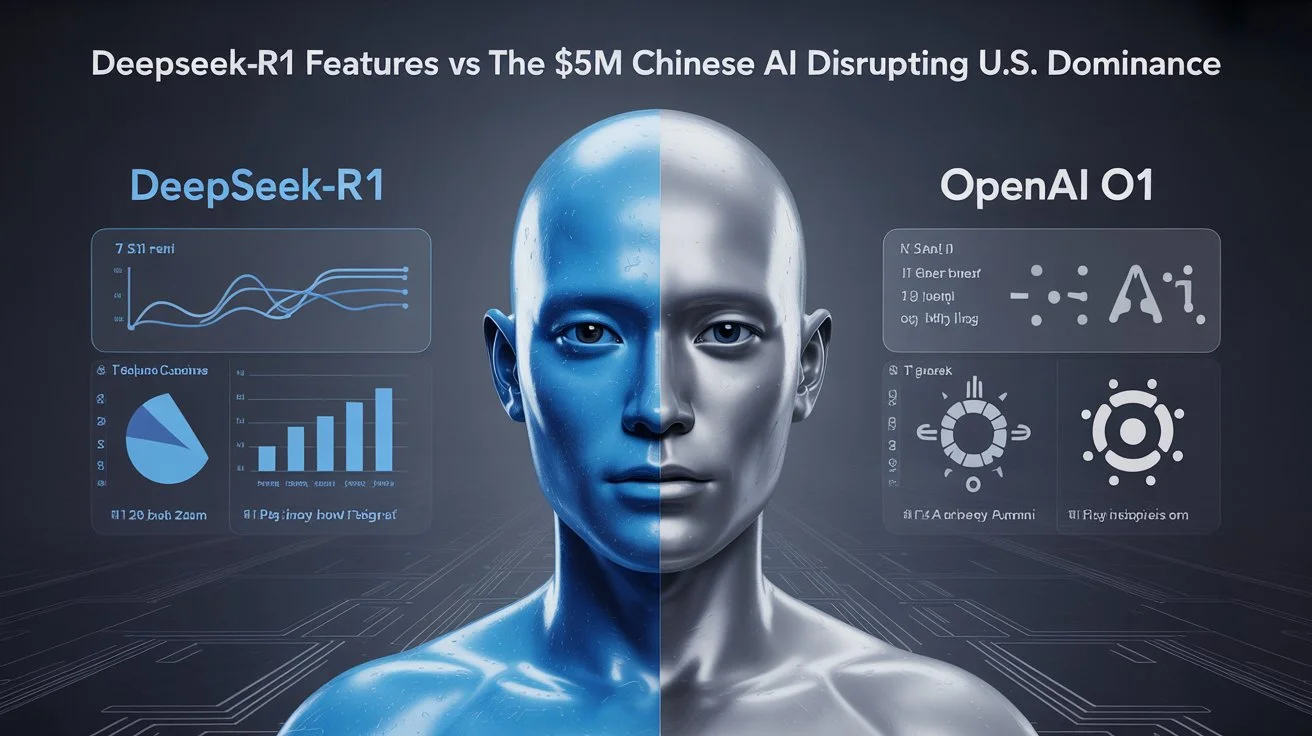I. Introduction: DeepSeek-R1 Features and the AI Revolution
Artificial Intelligence (AI) is the battleground of modern tech supremacy. In early 2025, a new challenger from China—DeepSeek—shook the industry with its disruptive open-source model, DeepSeek-R1. Released in January and significantly upgraded by May 2025, this model isn’t just a participant in the AI race—it’s becoming a front-runner.
What sets DeepSeek-R1 Features apart is not just its MIT license—allowing free commercial use—but also its astonishing efficiency. Built on a modest $5.58 million budget and trained using just 2.78 million GPU hours, R1 rivals the performance of American models backed by billion-dollar budgets.
The financial markets reacted swiftly. Following DeepSeek-R1 release, U.S. tech stocks plummeted by billions, signaling the global implications of this leap in AI capability. DeepSeek is not just a technological threat—it’s a signal that AI leadership may be shifting eastward.
II. Benchmark Breakdown: DeepSeek-R1 vs OpenAI-o1
To measure R1’s true power, we compare it to OpenAI’s top-tier models across industry benchmarks:
| Benchmark | DeepSeek-R1 Features | OpenAI-o1-1217 | DeepSeek-R1 Features 32B | OpenAI-o1-mini |
|---|---|---|---|---|
| AIME 2024 (Pass@1) | 79.8% | 79.2% | 72.6% | 63.6% |
| Codeforces (%) | 96.3% | 96.6% | 90.6% | 93.4% |
| GPQA Diamond | 75.7% | 71.5% | 58.7% | 62.1% |
| MATH-500 | 97.3% | 96.4% | 90.0% | 94.3% |
| MMLU | 90.9% | 91.8% | 85.2% | 87.4% |
| SWE-bench | 49.3% | 48.9% | 36.8% | 41.6% |
Key Takeaways:
- R1 leads in AIME, MATH-500, GPQA, and SWE-bench.
- OpenAI-o1 retains an edge in Codeforces and MMLU.
- Even distilled R1 variants (like R1-32B) outperform OpenAI’s o1-mini.
This isn’t just close competition. DeepSeek’s models are excelling with a fraction of the resources, proving that innovation can outmatch brute-force scale.
III. Autonomous Reasoning: When AI Thinks for Itself
DeepSeek-R1 Features doesn’t just solve problems—it thinks about how to solve them. In benchmark tasks, it often pauses and reflects, using phrases like:
“Wait, wait. That’s an aha moment I can flag here.”
This “inner dialogue” is made possible through Reinforcement Learning (RL), which trains models to evaluate actions and outcomes—just like a human would.
Future Implications:
- Science: Models can autonomously test hypotheses.
- Education: Real-time personalized tutoring.
- Healthcare: Diagnostic support through intuitive reasoning.
Risks Ahead:
- Ethical Drift: AI values may misalign with ours.
- Workforce Displacement: Autonomous systems could replace cognitive roles.
- Security Concerns: Autonomous AI could be manipulated.
As AI becomes more self-guided, the urgency for governance, auditing, and alignment grows exponentially.
IV. Why DeepSeek’s Training Wins: Simpler, Smarter, Stronger
R1’s strength lies in its training pipeline, which can be broken into four strategic phases:
- Better Base Models – Start strong with superior foundational data.
- Distillation – Compress knowledge from large models to smaller, faster ones.
- Supervised Fine-Tuning (SFT) – Train on curated labeled tasks.
- Reinforcement Learning (RL) – Refine reasoning and autonomy post-SFT.
Key Insight:
DeepSeek-R1 proved that applying RL on top of SFT-distilled models yields far better results than training RL from scratch.
Efficiency By Design:
- Cost: $5.58M vs OpenAI’s billions
- GPU Hours: 2.78M vs tens of millions
This new strategy is a blueprint for the next generation of efficient, high-performance models. It lowers the barrier to entry for AI developers across the world.
V. Conclusion: The New AI World Order
DeepSeek-R1 is not just another model—it’s a statement. With limited resources and strategic innovation, a Chinese lab has shaken the global AI ecosystem.
What DeepSeek-R1 Proves:
- Open-source can beat closed models.
- Training strategy matters more than scale.
- Autonomy is the next frontier in AI.
For the U.S. and companies like OpenAI, this is a wake-up call: adapt fast or fall behind. The future of AI is no longer concentrated in Silicon Valley. It’s global, fast-moving, and fiercely competitive.
Sources & References:
- DeepSeek R1 Overview on Hugging Face
- Benchmark Comparisons: DeepSeek-R1 Features vs OpenAI
- DeepSeek Reinforcement Learning Whitepapers
- SWE-bench, AIME, GPQA Public Benchmarks
- OpenAI o1 Performance Releases
Want more cutting-edge AI insights? Follow TodayTechLife.com for the latest in open-source AI, benchmark news, and the future of intelligence.
Q1. What is DeepSeek-R1 Features and why is it important?
A: DeepSeek-R1 is an open-source AI model developed by a Chinese company, DeepSeek. Released in 2025, it gained attention for matching or outperforming OpenAI’s o1 model on benchmarks like MATH-500, AIME, and GPQA—while using only $5.58M and fewer GPU resources. Its open-source nature and low cost make it a game-changer in AI development.
Q2. Is DeepSeek-R1 Features better than OpenAI’s o1 model?
A: In many areas, yes. DeepSeek-R1 beats OpenAI o1 in complex reasoning, mathematical tasks, and general problem-solving. While OpenAI retains a slight edge in some benchmarks like Codeforces, the overall performance of DeepSeek-R1 is highly competitive—and in some cases superior.
Q3. How was DeepSeek-R1 trained with such a low budget?
A: DeepSeek used a unique training pipeline: strong base model → distillation → supervised fine-tuning → reinforcement learning. This efficient strategy allowed high performance with only 2.78 million GPU hours and minimal spending, proving that smart methodology can beat raw scale.
Q4. Is DeepSeek-R1 Features really open-source?
A: Yes. DeepSeek-R1 is licensed under MIT, meaning it is fully open-source and can be used commercially without restrictions. This sets it apart from most high-end models, which are usually proprietary.
Q5. What can DeepSeek-R1 Features be used for?
A: DeepSeek-R1 can power applications in software development, education, healthcare, and even scientific discovery. Its autonomous reasoning abilities make it ideal for tasks requiring critical thinking and problem-solving.




